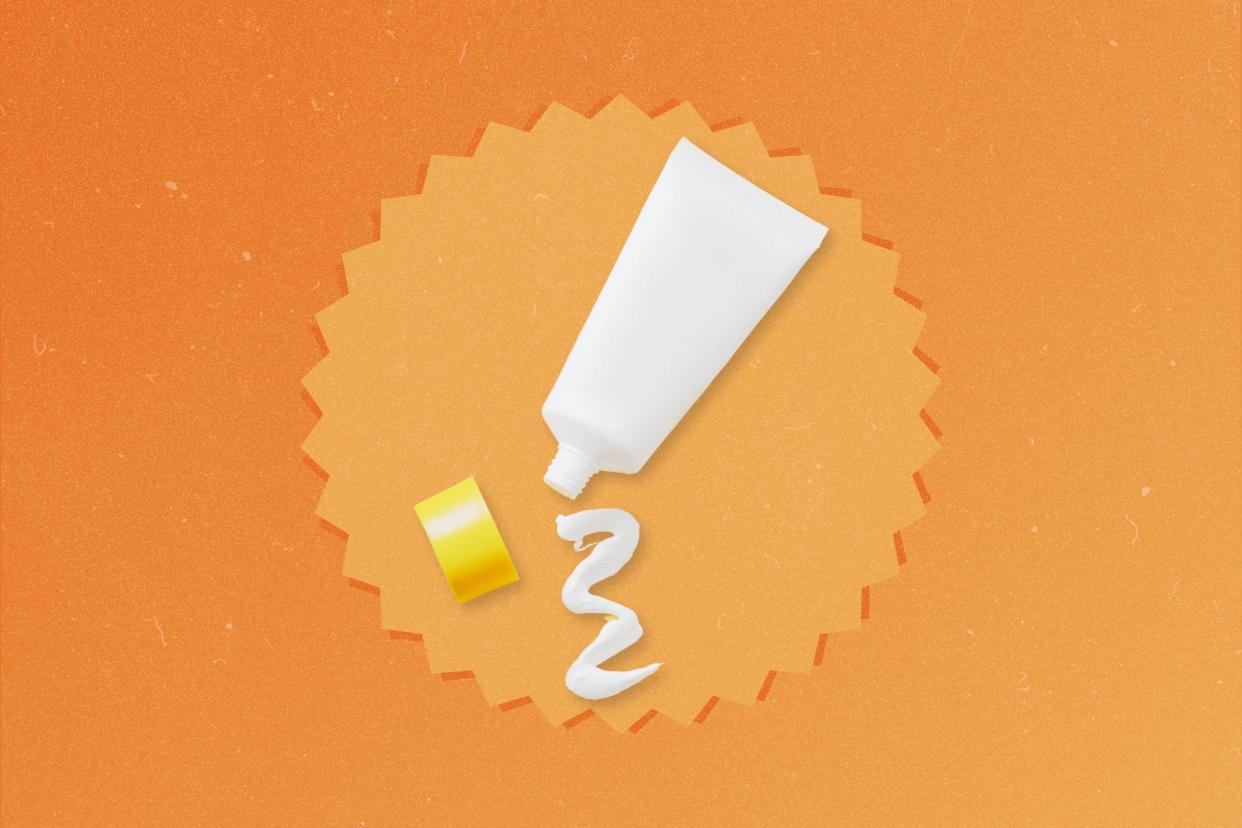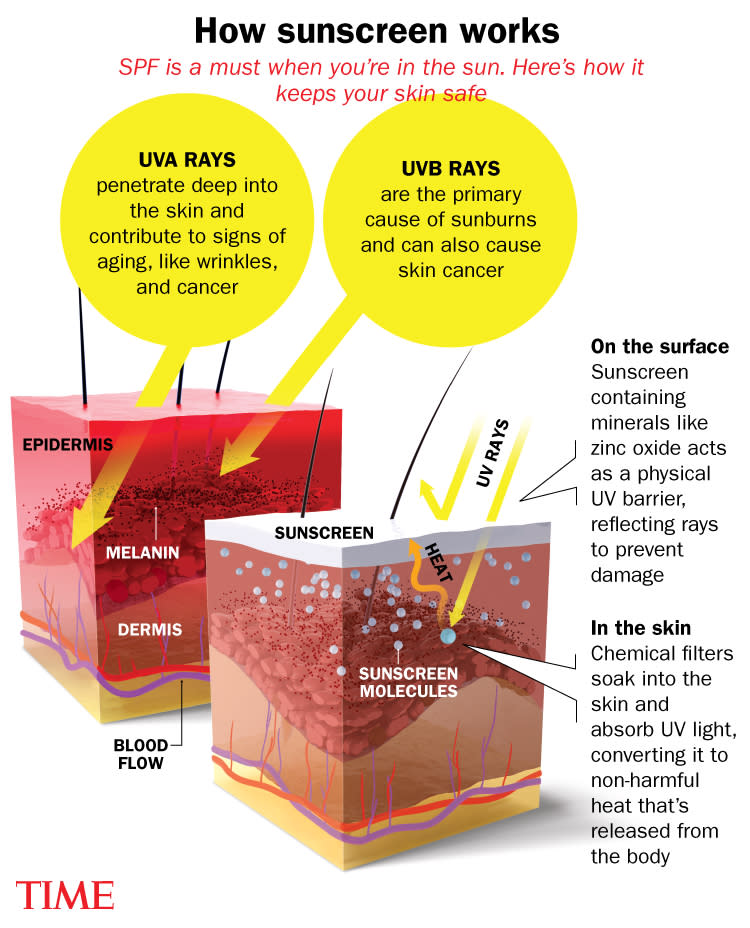What's the Best Kind of Sunscreen?

Credit - Photo-Illustration by TIME; Getty Images
Sunscreen is a $10 billion business, with a seemingly endless array of products available for sale. Walk into your local drugstore and you’ll find chemical and mineral formulas in virtually every SPF count and format imaginable, from creams to sprays to sticks.
So which one should you throw in your beach bag this summer? Here’s how to choose the right sunscreen, according to dermatologists.
What’s the difference between chemical and mineral sunscreens?
There are two major types of sunscreen: chemical and mineral (also known as physical) formulas. They serve the same purpose—preventing sunburns and other skin damage from the sun’s UV radiation—but they do so in different ways.
Sunscreens made from the minerals titanium dioxide and zinc oxide create a physical barrier atop the skin that reflects UV light. Chemical sunscreens, meanwhile, feature active ingredients that sink into the skin and absorb UV rays “like a sponge,” explains Dr. Raman Madan, chief of dermatology at Glen Cove Hospital in New York. In the U.S., these include chemicals such as homosalate, oxybenzone, avobenzone, octinoxate, octisalate, and octocrylene.

Is chemical or mineral sunscreen better?
Many people prefer chemical formulas because they sink into the skin well, whereas mineral sunscreens can leave a chalky white residue. But that residue is a visible signal of these products’ staying power; mineral formulas tend to last longer than chemical sunscreens, says Dr. Abel Torres, chair of the University of Florida College of Medicine’s dermatology department. “If you know you’re going to be on the beach for a long time, mineral may be a better choice because you won’t have to worry about having to reapply it as much,” he says.
People with acne-prone skin may also benefit from a mineral sunscreen, since research suggests zinc can help clear blemishes, Torres notes. Those with sensitive skin may also do better with a mineral formula, Madan says, because—unlike chemical sunscreens—these products don’t sink deep into the skin, so “it’s almost impossible to be allergic” to them.
For the same reason, people who are skittish about product safety may want a mineral formula. Recent research shows that ingredients used in chemical sunscreens enter the bloodstream after soaking into the skin, and other studies (some conducted in animals) suggest sunscreen chemicals like oxybenzone may be linked to hormone disruption and increased risks of certain cancers. It’s too soon to say exactly if or how absorption of these chemicals affects health, Madan says, but people who are concerned may find peace of mind in mineral formulas.
Read More: Backward Walking Is the Best Workout You’re Not Doing
There’s broad support for that idea. The U.S. Food and Drug Administration (FDA) has said titanium dioxide and zinc oxide can be generally considered safe and effective, but that there’s not enough data to say the same for chemicals used in sunscreens. (The agency has asked manufacturers to submit additional safety information for analysis.) And all 83 sunscreens verified by the Environmental Working Group, a nonprofit that performs independent analysis of sunscreen safety, are mineral formulas.
Still, Torres emphasizes that studies have not proven that chemical formulas are dangerous; they’ve only hinted at potential risks. And there are plenty of known benefits to wearing sunscreen, whether chemical or mineral—most importantly, reducing the risk of skin cancer. So if chemical formulas are the ones you’ll actually use, it’s better to choose those than to go out unprotected.
Which SPF is best?
Sun protection factor, or SPF, is a measure of how much UV radiation it will take to burn your skin while wearing sunscreen versus while going without. The higher the SPF, the more robust the protection.
The FDA recommends choosing a product with an SPF of at least 15, and the American Academy of Dermatology says it’s better to shoot for an SPF of 30 or above. People with fair skin may want to go even higher than that, Madan says—but after a certain point, SPF values offer diminishing returns. An SPF-50 formula offers such strong protection that upgrading to, say, SPF 100 offers only a tiny amount of additional benefit, he says.
Read More: The Unsettled—and Unsettling—Science of Lawn Chemicals
Just remember that regardless of which SPF you choose, you should reapply after a couple hours in the sun, especially if you’re swimming or sweating heavily. And, in addition to checking the SPF value, the Skin Cancer Foundation recommends choosing a sunscreen that is labeled with the phrase “broad-spectrum protection,” which means it protects against both UVA and UVB rays. UVA rays are responsible for wrinkles and skin aging, while UVB rays are the main cause of sunburns—but both are associated with skin cancer.
Is sunscreen best as a spray, lotion, or stick?
Sprays, sticks, and other formats are convenient, but Madan recommends a good old-fashioned cream if you have the choice. “It goes onto the skin a little bit thicker, so patients get more coverage out of a lotion,” he says.
Research backs up that point. Studies have shown that people often don’t apply enough sunscreen when they use aerosol products, since the spray can be easily carried away by the wind and many formulas are diluted by propellants and other ingredients. Using a spray also introduces the possibility of inhaling potentially harmful substances, particularly if applied directly to the face.
But something is always better than nothing, Madan says—so if a spray is all you have, use that. The one exception? The FDA has said it needs more data to prove that sunscreen powder is effective, so Madan typically recommends patients steer clear of those products in favor of tried-and-true formulations.
Write to Jamie Ducharme at jamie.ducharme@time.com.

